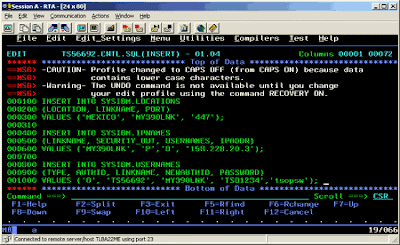I know a lot of us don't just work with SQL Server so I decided to share this one
Oracle today introduced Oracle(r) Database 11g, the latest release of the world's most popular database. With more than 400 features, 15 million test hours, and 36,000 person-months of development, Oracle Database 11g is the most innovative and highest quality software product Oracle have ever announced.
"Oracle Database 11g, built on 30 years of design experience, delivers the next generation of enterprise information management," said Andy Mendelsohn, senior vice president of Database Server Technologies, Oracle. "More than ever, our customers are facing the challenges of, rapid data growth, increased data integration, and data connectivity IT cost pressures. Oracle Database 10g pioneered grid computing, and more than half of Oracle customers have moved to that release. Oracle Database 11g delivers the key features our customers have asked for to accelerate broad adoption and growth of Oracle grids; representing real innovation, that addresses real challenges, as told to us by real customers."
Oracle Database 11g can help organizations take control of their enterprise information, gain better business insight, and quickly and confidently adapt to an increasingly changing competitive environment. To do this, the new release extends Oracle's unique database clustering, data center automation, and workload management capabilities. With secure, highly available and scalable grids of low-cost servers and storage, Oracle customers can tackle the most demanding transaction processing, data warehousing, and content management applications.
Real Application Testing Helps Reduce Time, Risk and Cost of ChangeOracle Database 11g features advanced self-management and automation features to help organizations meet service level agreements. For example, with organizations facing regular database and operating system software upgrades, and hardware and system changes, Oracle Database 11g introduces Oracle Real Application Testing, making it the first database to help customers test and manage changes to their IT environment quickly, in a controlled, cost effective manner.
Increase Return On Investment for Disaster Recovery SolutionsIn Oracle Database 11g, Oracle Data Guard enables customers to use their standby database to improve performance in their production environments as well as provide protection from system failures and site-wide disasters. Oracle Data Guard uniquely enables simultaneous read and recovery of a single standby database making it available for reporting, backup, testing and 'rolling' upgrades to production databases. By offloading workloads from production to a standby system, Oracle Data Guard helps enhance the performance of production systems and provides a more cost-effective disaster recovery solution.
Enhanced Information Lifecycle Management and Storage ManagementOracle Database 11g has significant new data partitioning and compression capabilities, for more cost-effective Information Lifecycle Management and storage management. Oracle Database 11g automates many manual data partitioning operations and extends existing range, hash and list partitioning to include interval, reference and virtual column partitioning. In addition, Oracle Database 11g provides a complete set of composite partitioning options, allowing storage management that is driven by business rules.
Building on its long-standing data compression capabilities, Oracle Database 11g offers advanced data compression for both structured and unstructured (LOB) data managed in transaction processing, data warehousing, and content management environments. Compression ratios of 2x to 3x or more for all data can be achieved with the new advanced compression capabilities in Oracle Database 11g.
Total Recall of Data ChangesThe new release also features "Oracle Total Recall," enabling administrators to query data in designated tables "as of" earlier times in the past. This offers an easy, practical way to add a time dimension to data for change tracking, auditing, and compliance.
Maximum Availability of InformationOracle has consistently led the industry in protecting database applications from planned and unplanned downtime. Oracle Database 11g continues this lead by making it easier for administrators to meet their users' availability expectations. New availability features include Oracle Flashback Transaction which makes it easy to back out a transaction made in error, as well as any dependent transactions; Parallel Backup and Restore which helps improve the backup and restore performance of very large databases; and 'hot patching,' which improves system availability by allowing database patches to be applied without the need to shut databases down. In addition, a new advisor - Data Recovery Advisor - helps administrators significantly reduce recovery downtime by automating problem investigation, intelligently determining recovery plan and handling multiple failure situations.
Oracle Fast FilesThe next-generation capability for storing large objects (LOBs) such as images, large text objects, or advanced data types � including XML, medical imaging, and three-dimensional objects - within the database. Oracle Fast Files offers database applications performance fully comparable to file systems. By storing a wider range of enterprise information and retrieving it quickly and easily, enterprises can know more about their business and adapt more rapidly.
Faster XMLOracle Database 11g includes significant performance enhancements to XML DB, a feature of Oracle database that enables customers to natively store, and manipulate XML data. Support for binary XML has been added offering customers a choice of XML storage options to match their specific application and performance requirements. XML DB also enables manipulation of XML data using industry standard interfaces with support for XQuery, Java Specification Requests (JSR)-170 and SQL/XML standards.
Transparent EncryptionOracle Database 11g continues to build on its unmatched security capabilities through the addition of significant enhancements. The new release features improved Oracle Transparent Data Encryption capabilities beyond column level encryption. Oracle Database 11g offers tablespace encryption that can be utilized to encrypt entire tables, indexes, and other data storage. Encryption is also provided for LOBs stored in the database.
Embedded OLAP CubesOracle Database 11g also provides data warehousing innovations. OLAP cubes are enhanced to behave as materialized views in the database. This allows developers to use industry standard SQL for data query, but still benefit from the high performance delivered by an OLAP cube. New Continuous Query Notification features allow applications to be immediately notified when important changes are made to database data without burdening the database with constant polling.
Connection Pooling and Query Result CachesThe performance and scalability features in Oracle Database 11g are designed to help organizations maintain a highly performant, scalable infrastructure to provide users' with the best quality of service. Oracle Database 11g further enhances Oracle's position as the industry's performance and scalability leader with new features such as Query Result Caches which improves application performance and scalability by caching and reusing the results of often called database queries and functions in database and application tiers, and Database Resident Connection Pooling which improves the scalability of web-based systems by providing connection pooling for non-multi-threaded applications.
Enhanced Application DevelopmentOracle Database 11g offers developers a choice of development tools, and a streamlined application development process that takes full advantage of key Oracle Database 11g features. These include new features such as Client Side Caching, Binary XML for faster application performance, XML processing, and the storing and retrieving of files. In addition, Oracle Database 11g also includes a new Java just-in-time Compiler to execute database Java procedures faster without the need for a third party compiler; native integration with Visual Studio 2005 for developing .NET applications on Oracle; Access migration tools with Oracle Application Express; and SQL Developer easy query building feature for fast coding of SQL and PL/SQL routines.
Enhanced Self-Management and AutomationThe manageability features in Oracle Database 11g are designed to help organizations easily manage enterprise grids and deliver on their users' service level expectations. Oracle Database 11g introduces more self-management and automation that will help customers reduce their system management costs, while increasing performance, scalability, availability and security of their database applications. New manageability capabilities in Oracle Database 11g include Automatic SQL and memory tuning, a new Partitioning Advisor which automatically advises administrators on how to partition tables and indexes in order to improve performance, and enhanced performance diagnostics for database clusters. In addition, Oracle Database 11g includes a new Support Workbench which provides an easy-to-use interface that presents database health-related incidents to administrators along with information on how to quickly manage the resolution of incidents.
Oracle is the #1 Database: Gartner 2006 Worldwide RDBMS Market Share Reports 47.1 Percent Share for OracleGartner recently published their market share numbers by operating system for 2006 based on total software revenues. According to Gartner, Oracle:
* Has 47.1 percent share (up from 46.8 percent in 2005);
* Has revenue growth of 14.9 percent, faster than the market average of 14.2 percent with US$7.2 Billions in revenues; and,
* Continues to hold more market share than its two closest competitors combined.
About Oracle Database 11gOracle Database is the only database designed for grid computing. With the release of Oracle Database 11g, Oracle is making the management of enterprise information easier than ever; enabling customers to know more about their business and innovate more quickly. Oracle Database 11g delivers superior performance, scalability, availability, security and ease of management on a low-cost grid of industry standard storage and servers. Oracle Database 11g is designed to be effectively deployed on everything from small blade servers to the biggest SMP servers and clusters of all sizes. It features automated management capabilities for easy, cost-effective operation. Oracle Database 11g's unique ability to manage all data from traditional business information to XML and 3D spatial information makes it the ideal choice to power transaction processing, data warehousing, and content management applications.
 Yes it looks like it is a done deal: News Corp. Appears to Have
Yes it looks like it is a done deal: News Corp. Appears to Have






